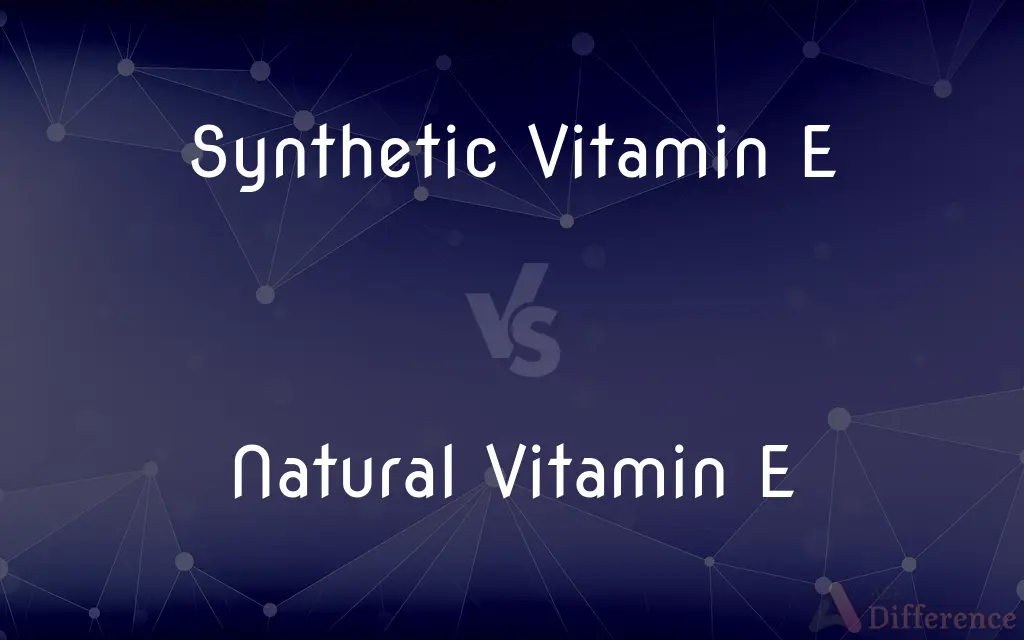Synthetic Vitamin E vs. Natural Vitamin E — What's the Difference?
By Urooj Arif & Maham Liaqat — Published on March 7, 2024
Natural Vitamin E (d-alpha-tocopherol) is better retained by the body than Synthetic Vitamin E (dl-alpha-tocopherol), offering superior bioavailability and potency.

Difference Between Synthetic Vitamin E and Natural Vitamin E
Table of Contents
ADVERTISEMENT
Key Differences
Natural Vitamin E, known chemically as d-alpha-tocopherol, is derived from plant oils and is recognized for its higher bioavailability, meaning it's more effectively utilized by the body. It's considered more potent due to its specific molecular structure, which aligns better with human metabolism, enhancing its antioxidant properties and efficacy in supporting immune function, skin health, and preventing cellular damage.
Synthetic Vitamin E, labeled as dl-alpha-tocopherol, is produced from petrochemicals and contains a mix of isomers, only one of which (about 12.5%) matches the natural form used by the body. This mix results in a less efficient interaction with the body's metabolic processes, making it less potent on a per-unit basis compared to its natural counterpart. Consequently, higher doses of synthetic Vitamin E might be required to achieve effects similar to those of natural Vitamin E.
The distinction between natural and synthetic Vitamin E also extends to their absorption and retention in the human body. Studies suggest that natural Vitamin E is retained significantly better, attributed to its specific isomeric form that the body prefers. This difference is crucial for individuals relying on supplementation for health reasons, as the natural form can be more effective in correcting deficiencies or supporting overall health.
Environmental and cost considerations also play a role in the choice between natural and synthetic Vitamin E. The extraction of natural Vitamin E from plant sources can be more environmentally taxing and costlier due to the complex extraction processes. In contrast, synthetic Vitamin E's petrochemical origin provides a more cost-effective but less eco-friendly option.
Despite these differences, both forms of Vitamin E play essential roles in dietary supplements and fortified foods. The choice between natural and synthetic forms may depend on individual health goals, budget constraints, and environmental concerns.
ADVERTISEMENT
Comparison Chart
Source
Plant oils
Petrochemicals
Bioavailability
Higher
Lower
Potency
More potent per unit
Less potent per unit
Body Retention
Better retained by the body
Less well retained
Environmental Impact
Higher due to extraction processes
Lower, but derived from non-renewable sources
Cost
Generally higher
Generally lower
Composition
Single isomer
Mixture of isomers
Compare with Definitions
Synthetic Vitamin E
Less bioavailable and potent than its natural counterpart.
Synthetic Vitamin E may require higher doses to match the effectiveness of natural forms.
Natural Vitamin E
Preferred for its eco-friendly source, despite higher environmental impact.
Consumers choose natural Vitamin E for its plant-based origin, aligning with green lifestyles.
Synthetic Vitamin E
Contains both active and inactive forms of Vitamin E.
Only a fraction of synthetic Vitamin E isomer is utilized by the body.
Natural Vitamin E
Generally costs more due to extraction methods.
The price of natural Vitamin E reflects the complex process of deriving it from plant oils.
Synthetic Vitamin E
Widely used in fortified foods and supplements.
Its lower cost makes synthetic Vitamin E a popular choice for mass-produced food products.
Natural Vitamin E
More effectively utilized by the body for antioxidant protection.
Natural Vitamin E is preferred for its superior support against oxidative stress.
Synthetic Vitamin E
Produced from petrochemicals, with a mix of isomers.
Synthetic Vitamin E, labeled as dl-alpha-tocopherol, is common in many supplements.
Natural Vitamin E
Derived from plant sources, offering higher bioavailability.
Natural Vitamin E supplements often come from sunflower, almond, or avocado oils.
Synthetic Vitamin E
More cost-effective but with environmental concerns.
Although cheaper, synthetic Vitamin E's petrochemical origin raises ecological issues.
Natural Vitamin E
Contains only the d-alpha-tocopherol isomer.
Look for d-alpha on supplement labels to identify natural Vitamin E.
Common Curiosities
Can the body utilize all forms of Vitamin E?
While the body can utilize both forms, it prefers the natural d-alpha-tocopherol for its cellular processes.
Is natural Vitamin E worth the higher cost?
For those seeking maximum health benefits and bioavailability from supplements, natural Vitamin E may offer better value despite its higher price.
What makes natural Vitamin E more bioavailable than synthetic?
Natural Vitamin E's structure is more compatible with human metabolism, enhancing its absorption and retention.
How can I identify natural and synthetic Vitamin E in products?
Natural Vitamin E is listed as "d-alpha-tocopherol," while synthetic is labeled "dl-alpha-tocopherol" on ingredient lists.
What are the main dietary sources of natural Vitamin E?
Nuts, seeds, and vegetable oils are rich in natural Vitamin E, providing it in its most bioavailable form.
Can Vitamin E supplementation improve skin health?
Vitamin E is known for its skin health benefits, with natural Vitamin E being particularly effective due to its higher potency.
Why is synthetic Vitamin E widely used in supplements?
Its lower cost and ease of production make it a common choice for manufacturers, despite its lower bioavailability.
Why is synthetic Vitamin E considered less potent?
Due to its mixed isomers, only a portion of synthetic Vitamin E matches the body's preferred form, reducing its overall potency.
Do both forms of Vitamin E provide antioxidant benefits?
Yes, both forms act as antioxidants, though natural Vitamin E is more effective per unit due to its bioavailability.
Are there environmental benefits to choosing natural Vitamin E?
While derived from renewable plant sources, the extraction of natural Vitamin E can be resource-intensive, posing a trade-off between source sustainability and processing impact.
Share Your Discovery

Previous Comparison
Economy Car vs. Compact Car
Next Comparison
Metamucil vs. PsylliumAuthor Spotlight
Written by
Urooj ArifUrooj is a skilled content writer at Ask Difference, known for her exceptional ability to simplify complex topics into engaging and informative content. With a passion for research and a flair for clear, concise writing, she consistently delivers articles that resonate with our diverse audience.
Co-written by
Maham Liaqat












































